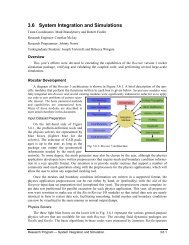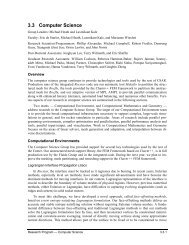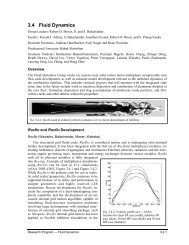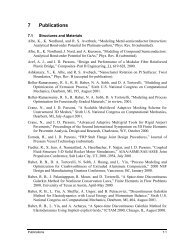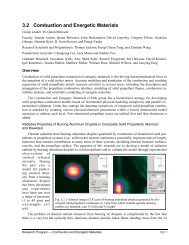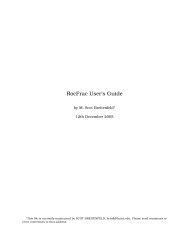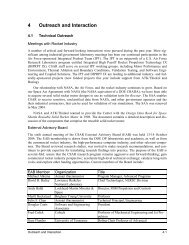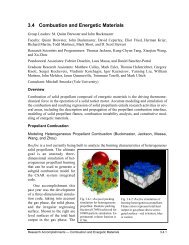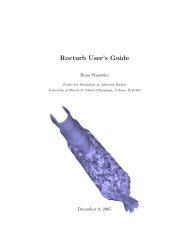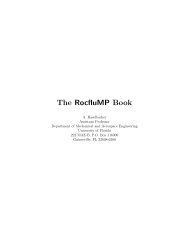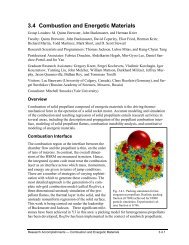User's Guide - Center for Simulation of Advanced Rockets
User's Guide - Center for Simulation of Advanced Rockets
User's Guide - Center for Simulation of Advanced Rockets
Create successful ePaper yourself
Turn your PDF publications into a flip-book with our unique Google optimized e-Paper software.
JCSE Users <strong>Guide</strong><strong>Center</strong> <strong>for</strong> <strong>Simulation</strong> <strong>of</strong> <strong>Advanced</strong> <strong>Rockets</strong>University <strong>of</strong> Illinois at Urbana-Champaign2260 Digital Computer LaboratoryUrbana, ILJCSE Users <strong>Guide</strong> 2/29/08
JCSE Users <strong>Guide</strong> Page 1Title:Author:Subject:JCSE Users <strong>Guide</strong>Mark BrandyberryDocumentation <strong>of</strong> the use <strong>of</strong> the JCSE automated build and test systemRevision: Rev. 0Revision History Revision 0: Initial Release <strong>for</strong> JCSE 1.0Effective Date: 12/15/2006Printed on Date: 2/29/08
JCSE Users <strong>Guide</strong> Page 21.0 IntroductionThe JCSE application is an automated build and test driver designed to operate on a singleclustered machine to automate the build and regression testing needs <strong>of</strong> the Rocstar code. Thereare three s<strong>of</strong>tware modules that comprise the JCSE dedicated build and test system. The javabasedmodules are included in the JCSE package.JBuild: Automated build driver and build result analyzer. This s<strong>of</strong>tware is written in Java.JTest: Automated regression test driver and result analyzer. This s<strong>of</strong>tware is written in Java.Rocdiff: Utility to compare variables in Rocstar HDF files <strong>for</strong> “equivalence” using severalcriteria. This module is a utility written by C. McLay [McClay, 2005], and is used by the JTestsystem. This s<strong>of</strong>tware is written in C++, and uses file I/O routines from the Rocstar s<strong>of</strong>twarebase in order to read the Rocstar output files.The build and test program as currently used involves a dedicated build and test clusterconfigured specifically to build Rocstar in several different configurations, and then toregression test those builds. The Hilbert computational cluster is a small Linux-based computingcluster <strong>for</strong>med from cast-<strong>of</strong>f hardware from the old Linux-based Turing cluster. There are 32total processors in 16 nodes, and a login node with 4 processors and 4 GB <strong>of</strong> RAM. In addition,a Myrinet High Speed Interconnect (HSI) and a small (800GB) RAID array are provided.This cluster is dedicated to a small user base, and will almost exclusively be used as a build andregression testing plat<strong>for</strong>m <strong>for</strong> the Rocstar computer code. The cluster uses the TORQUE jobscheduling system in conjunction with the MOAB job submission optimizer. Reference[Brandyberry, 2006] describes the hardware and s<strong>of</strong>tware environment <strong>for</strong> the Hilbert cluster indetail.2 Purpose and MethodsThe purpose <strong>of</strong> the JCSE application is to provide an integrated build and regression testingsystem that operates in a single environment in a comprehensive manner. It is currentlyconfigured to run on Linux, although, since it is written in Java, it could run on any plat<strong>for</strong>m onwhich the Java 5 jdk is available. The JBuild module checks out Rocstar, builds it perin<strong>for</strong>mation in configuration files, analyzes the build logs, checks <strong>for</strong> required output files, anddrives testing by starting the JTest module. JTest uses a set <strong>of</strong> preconfigured test archives andruns the executable(s) specified by JBuild with sets <strong>of</strong> test archives. JTest verifies that each testcompletes (by searching <strong>for</strong> a user-defined string in the job dump), and then calls Rocdiff tocompare the numerical results <strong>for</strong> each test against a set <strong>of</strong> gold-standard output files <strong>for</strong> that test.3 Building and RunningJCSE is distributed as a java .jar file called JCSE.jar, and requires no further building on anyplat<strong>for</strong>m where a Java 5 runtime environment is available. The Rocdiff code should be built onPrinted on Date: 2/29/08
JCSE Users <strong>Guide</strong> Page 3the target plat<strong>for</strong>m. See [McLay, 2005] <strong>for</strong> directions on building Rocdiff. If it should benecessary to modify applications in JCSE, see the Developer’s guide <strong>for</strong> in<strong>for</strong>mation.3.1 JBuildThe JBuild program is written in Java 5, and is completely command-line and file driven. NoGUI elements are used, so that the program will run and per<strong>for</strong>m the same on any plat<strong>for</strong>m onwhich Java 5 is installed. However, the system issues Unix-specific commands to interact withexternal systems such as CVS, SSH, MOAB, and TORQUE. This makes the system Unixspecificat this time, as well as tied-in to the MOAB and TORQUE job control systems (JTestactually uses the MOAB and TORQUE systems <strong>for</strong> job submission). The JCSE system isinstalled on the Hilbert cluster at the following location: /csar/s<strong>of</strong>tware32/JBuild .The basic flow <strong>of</strong> control <strong>for</strong> the JBuild program is shown in figure 3.1. The Linux Cron utilityis used to start a small script that then starts the JBuild program at the specified time. The scriptchanges directories to the JBuild directory, and then uses the Java runtime interpreter to start theJBuild program with the following commandline:java -classpath JCSE.jar:mail.jar:activation.jar:jdom.jar cse.JBuild.JBuild -v -cconf/paths.xmlPrinted on Date: 2/29/08
JCSE Users <strong>Guide</strong> Page 4Figure 3.1 JBuild System Flow <strong>of</strong> ControlThe first portion <strong>of</strong> this command simply starts the java interpreter with the –classpath switch toset the paths to the required libraries that are not part <strong>of</strong> the normal java runtime environment.These files are included in the JCSE distribution. The JBuild program is located in theJCSE.JBuild package inside the JCSE.jar file, and thus to load it into the Java interpreter, thepath JCSE.JBuild.JBuild is required. The –v flag indicates verbose mode, where more text anderror in<strong>for</strong>mation is output. The –c flag is used with JBuild to provide the path to the mainpaths.xml configuration file (see section 3.2.1.1). This file contains the paths to all otherrequired configuration files <strong>for</strong> JBuild.Once all <strong>of</strong> the configuration in<strong>for</strong>mation is available to JBuild, the main build loop can bestarted.The build loop uses the same Rocstar source code base <strong>for</strong> each build, and thus depends on amakefile clean command to work effectively to clear out the previous build from the source codedirectories, as well as the PREFIX flag to place each executable in a unique place <strong>for</strong> lateranalysis and testing. Thus, the actual builds, as well as the makefile and the makefile cleancommands are tested. The builds are per<strong>for</strong>med in serial, and the source code directory cleanedbetween builds. The clean step is not shown in figure 3.1. The build command to be used <strong>for</strong>each build is provided in an XML file <strong>of</strong> commands that control the builds(RocstarBuild.xml). The path to and name <strong>of</strong> that build control file are provided in thepaths.xml file that is provided to JBuild on the command line.The basic build loop goes through the following steps:• Changes directories to the source code directory, and issues the first build command fromthe RocstarBuild.xml file.• As the build progresses, collect all <strong>of</strong> the screen output from the build into a log file.• When the build has completed, analyze the log file <strong>for</strong> errors or warnings. A list <strong>of</strong>“error” or “warning” keywords is used to scan the file <strong>for</strong> lines that are likely to containerrors or warnings. JBuild then writes an XML file containing records <strong>for</strong> each error orwarning found. Note that all lines back to the previous compiler execution statement arecaptured to give context <strong>for</strong> each error or warning. Also, any error or warning within auser-specified number <strong>of</strong> lines <strong>of</strong> another error or warning are grouped together into onerecord.• Verify that all the required output files listed in the build verification file are actuallypresent in the build output. The build fails if required files are not present. Verify that alloptional build files listed in the build verification file are actually present in the buildoutput. A warning is issued if optional files are missing, but the build is consideredcomplete. These are normally utility codes that are not required <strong>for</strong> Rocstar to run but arenormally built along with Rocstar.Printed on Date: 2/29/08
JCSE Users <strong>Guide</strong> Page 5• Write the XML log file <strong>for</strong> the build (actually occurs throughout the build process, but isfinalized now).• Using the log file(s), transfer the build results to the remote database (this functionality isplanned, but not currently implemented).• If testing is specified <strong>for</strong> this build, spawn a new thread <strong>of</strong> JTest, providing it the newexecutable path to test.• Issue a clean command in the build directory.• If there are further builds, issue the next build command.• When there are no further builds, wait <strong>for</strong> all JTest threads (if any) to complete, and exit.Note that <strong>for</strong> the above loop to work correctly <strong>for</strong> all but the first build, the clean command mustoperate correctly. Also, the Rocstar makefile allows specifying a “PREFIX” flag, so that that thebuild results may be placed in a directory away from the source directory. This flag is used sothat the build results (i.e., the executable programs) are not “cleaned” between builds, so thateach executable is available <strong>for</strong> testing as further builds are completed. Thus, while the buildsare serial, the tests <strong>for</strong> the builds execute in parallel as each build is completed.3.2 JTestThe JTest module is also a pure-java program that is located in the JCSE.JTest package. It can beused in two modes: as a separate, command-line driven program, distinct from running JBuild, oras an object constructed and used by JBuild. The main method in the JTest class either reads andthen processes the command line as a standalone program, or JBuild constructs a JTest instance,and then calls the processCommandLine method on that JTest instance, sending it the samecommand line as would have been used in the standalone program call.JTest is designed to test a single executable instance, running multiple tests on that executable.The command line takes the fully-qualified path to the executable to be tested. Several otherflags, including the name <strong>of</strong> the test group to use <strong>for</strong> that executable may be (and sometimesmust be) specified. A test group corresponds to a sub-directory in the main test directory (asspecified in the paths.xml file discussed in section 3.2.1, and documented in appendix sectionA.1). That subdirectory must have test archives (discussed below) or links to test archives in it.A valid JTest command line to execute JTest as a standalone program will look like thefollowing:java –classpath JCSE.jar cse.JTest.JTest [-v] [-c configfile] [testgroup2]…The portions <strong>of</strong> this command line are:• java : the Java interpreter.Printed on Date: 2/29/08
JCSE Users <strong>Guide</strong> Page 6• –classpath JCSE.jar : classpath flag to tell the interpreter where to look <strong>for</strong> the JTestprogram.• cse.JTest.JTest : package-specified program invocation.• -v : optional verbose flag.• -c configfile : optional path to configuration file. Must be the absolute path, orrelative to where JTest is run. It is assumed to be relative to the executable and located in./conf/paths.xml if not provided.• : A required text label <strong>for</strong> the testing set. Used as part <strong>of</strong> the test directorynaming convention. “label” can be any string with no spaces.• : Required absolute path to the executable to be tested.• [testgroup2]… : list <strong>of</strong> test groups to run. At least one testgroup is required. Others are optional. Separate by spaces, with no spaces in test groupnames. See section 3.2.2.1 <strong>for</strong> a discussion <strong>of</strong> a test group, and section 3.2.2.2 <strong>for</strong> adiscussion <strong>of</strong> a test archive.4 Input/Output4.1 JBuildOnce the paths.xml file is loaded, several other configuration files are read. These files are:• paths.xml: full paths to all the main directories needed to run JBuild. Also used byJTest.• tools.xml: Full paths to tools used by JBuild and JTest, such as the CVS client, andthe pj_all job submission script. Also used by JTest.• params.xml: miscellaneous parameters, <strong>for</strong> the most part having to do with timeoutsettings <strong>for</strong> both JBuild and JTest.• mailParams.xml: parameters used to specify mail server settings <strong>for</strong> sendingdeveloper notification messages.• RocstarBuild.xml: This is the main file <strong>for</strong> defining what builds will be per<strong>for</strong>med,whether they will be tested, how they will be checked, etc.• Build Verification Files: There are several files <strong>of</strong> this type that define sets <strong>of</strong> output filesfrom different builds that should be verified to exist after a build completes. Differentbuild flags can produce different sets <strong>of</strong> files, so a unique verification specification isrequired <strong>for</strong> each build that has a unique file set. There are currently 3 files <strong>of</strong> this type.• webConnections.xml: A prototype file <strong>for</strong> defining parameters to be used to submitbuild in<strong>for</strong>mation to a centralized database. Currently read, but not functional.Printed on Date: 2/29/08
JCSE Users <strong>Guide</strong> Page 7• webServerProperties.xml: A prototype file <strong>for</strong> defining parameters to be used todefine the server properties in order to submit build in<strong>for</strong>mation to a centralized database.Currently read, but not functional.See Appendix A <strong>for</strong> details on the contents <strong>of</strong> these files.4.2 JTest4.2.1 Test GroupsA test group is a set <strong>of</strong> test archives (see section 4.2.2 <strong>for</strong> details on test archives) contained in aspecific, named directory. That directory must be located under the directory defined by thedatapath key defined in the paths.xml file (see section A.1). The name <strong>of</strong> the directorymust be the same as the testgroup name specified on the JTest command line. Each testgroupmust have a unique name and a corresponding unique directory. Test groups are defined togroup sets <strong>of</strong> tests that can be run using specific sets <strong>of</strong> Rocstar build flags, so that special testingsetups are easy to develop. Generally, a test group directory will actually have links pointing totest archives in a test archive library. In this manner, a single test (located in the test library) maybe associated with multiple test groups without having to duplicate it (they can be large) andwithout having to maintain the configuration <strong>of</strong> separate copies.As will be discussed in section 4.2.2, a test archive is a tar’d, gzip’d archive containing acomplete test dataset. Thus, a test group is basically a directory containing either a set <strong>of</strong> these.tgz files, or links to .tgz files. JTest then expands these archives into a specific test directory(constructed and time-stamped at runtime), and runs them with the specified executable.4.2.2 Test ArchivesA test archive is simply a tar’d, gzip’d archive containing a runnable Rocstar dataset. It musteither have the extension .tgz or .tar.gz. No other extensions will be processed (e.g., youcan’t use .zip). See [Fiedler, 2006] <strong>for</strong> the actual contents <strong>of</strong> a Rocstar dataset. There must beseveral other items in a test archive, however, that are not in a normal Rocstar dataset:• JobProperties.xml file: Controls the job submission by providing parametersrequired by the pj_all script used to submit Rocstar jobs. See section B.1 <strong>for</strong> adescription <strong>of</strong> the JobProperties.xml file. JTest reads this file to <strong>for</strong>mat the command lineto pj_all to submit each test job.• diffs.xml file : definitions <strong>of</strong> comparisons to be made by the Rocdiff utility <strong>of</strong> “Goldstandard” results against the test results produced by this test run. See section B.2 <strong>for</strong> adefinition <strong>of</strong> this file.• AttributeMetrics XML file(s): One or more metrics files to define which variables andwhat comparisons are to be made by the program. It allows defining less than, greaterthan, or equal to comparisons, and a success criteria <strong>for</strong> each comparison. See section B.3<strong>for</strong> a description <strong>of</strong> this file.Printed on Date: 2/29/08
JCSE Users <strong>Guide</strong> Page 8• Gold directories: Usually called “Gold”, and containing subdirectories <strong>for</strong> each module<strong>for</strong> which gold standard results are supplied. Each subdirectory (<strong>of</strong>ten called “Rocflo”,“RocburnAPN”, “Rocfrac”, etc.) should contain .hdf result files <strong>for</strong> Rocdiff to comparewith the corresponding results from the current test. Directory names are actuallycontained in the diffs.xml file described in section B.2.4.2.3 RocdiffUse and architecture <strong>of</strong> the Rocdiff utility code is described in [McLay, 2005]. The utility isdesigned to do one thing: Take two HDF files (or two directories <strong>of</strong> HDF files) that are outputsfrom the Rocstar code and compare the data in them. The two files must have identical number<strong>of</strong> variables and identical mesh connectivity in<strong>for</strong>mation, since Rocdiff will per<strong>for</strong>m a point-bypoint(spatial points) comparison <strong>of</strong> the data.Rocdiff can currently calculate two difference metrics <strong>for</strong> variables in HDF files:• Maximum difference• Mean Square ErrorThe maximum difference is an absolute difference metric across all points <strong>for</strong> each variable, notscaled to anything. The mean square error is also not scaled, but is less sensitive to outlier values,since it is calculating an average error.JTest uses Rocdiff as an external program, calling it with a command line set <strong>of</strong> parameters inorder to compare the results <strong>of</strong> regression tests to the results stored in the Gold standarddirectories within each test archive (see section 4.2.2 <strong>for</strong> a description <strong>of</strong> a test archive). Theoutput from Rocdiff is captured by JTest and analyzed based on the contents <strong>of</strong> theAttributeMetrics file discussed in section 4.2.2 and Appendix section B.3.5.0 Examples and Test Problems5.1 RocbuildOn Hilbert, JCSE is currently configured in /csar/s<strong>of</strong>tware32/JBuild as:JBuildactivation.jarconfattributeMetricsRocburn.xmlattributeMetricsRocfrac.xmlattributeMetricsRocflo.xmlattributeMetricsRocsolid.xmlattributeMetricsRocflu.xmlpaths.xmlPrinted on Date: 2/29/08
JCSE Users <strong>Guide</strong> Page 9rocstarPlain.xmlrocstarStatic.xmlrocstarRocman3.xmlrocstarStaticRocman3.xmlwebServerProperties.xmlmailParams.xmlRocstarBuild.xmltools.xmldiffs.xmlparams.xmlwebConnections.xmlJCSE.jarjdom.jarmail.jarrunBuild.shAll builds occur under a directory located at:/csar1/autobuild/rocstar3That directory contains all the date-stamped builds <strong>for</strong> Rocstar, both <strong>for</strong> JBuild runs, and <strong>for</strong> themulit-plat<strong>for</strong>m Rocbuild code.5.2 JTestThe JTest runtime directory on Hilbert is:/csar1/autotestIn that directory is the structure:autotestparticleTestsplainTestsACMFloPropRst.tgz -> ../testBank/ACMFloPropRst.tgzArienti10nd.tgz -> ../testBank/Arienti10nd.tgzEPistonFluFrac.tgz -> ../testBank/EPistonFluFrac.tgzLSFloFrac.tgz -> ../testBank/LSFloFrac.tgzLSFluFrac.tgz -> ../testBank/LSFluFrac.tgzscaleFloSolid2.tgz -> ../testBank/scaleFloSolid2.tgzRM2TestsEPistonFluFrac.tgzLSFloFrac.tgzLSFluFrac.tgzscaleFloSolid2.tgzRUNDIR[Hundreds <strong>of</strong> test runs]staticTests.Printed on Date: 2/29/08
JCSE Users <strong>Guide</strong> Page 10ACMFloPropRst.tgz -> ../testBank/ACMFloPropRst.tgzArienti10nd.tgz -> ../testBank/Arienti10nd.tgzLSFloFrac.tgz -> ../testBank/LSFloFrac.tgzscaleFloSolid2.tgz -> ../testBank/scaleFloSolid2.tgztestBankACMFloPropRst.tgzArienti10nd.tgzEPistonFluFrac.tgzLSFloFrac.tgzLSFluFrac.tgzscaleFloSolid2.tgzturbulenceTestsACMFloPropRst.tgz -> ../testBank/ACMFloPropRst.tgzArienti10nd.tgz -> ../testBank/Arienti10nd.tgzEPistonFluFrac.tgz -> ../testBank/EPistonFluFrac.tgzLSFloFrac.tgz -> ../testBank/LSFloFrac.tgzLSFluFrac.tgz -> ../testBank/LSFluFrac.tgzscaleFloSolid2.tgz -> ../testBank/scaleFloSolid2.tgzweeklyTestsAs you can see from this list, the actual test archives are contained in the directories “RM2Tests”and “testBank”. Other test groups, such as staticTests or turbulenceTests pick tests from thetestBank through links to the archive files. In this manner, duplication <strong>of</strong> test archives isavoided.ReferencesBrandyberry, M., Hilbert Build and Test Cluster Operational Configuration, University <strong>of</strong>Illinois, Revision 0, December 2006.Fiedler, R., Rocstar 3 Solid Propellant Rocket <strong>Simulation</strong> S<strong>of</strong>tware User’s <strong>Guide</strong>, <strong>Center</strong> <strong>for</strong><strong>Simulation</strong> <strong>of</strong> <strong>Advanced</strong> <strong>Rockets</strong>, University <strong>of</strong> Illinois, Revision 1, December 15, 2006.McLay, C., Rocdiff User’s <strong>Guide</strong>, <strong>Center</strong> <strong>for</strong> <strong>Simulation</strong> <strong>of</strong> <strong>Advanced</strong> <strong>Rockets</strong>, University <strong>of</strong>Illinois, Revision 1, December 9, 2005.Printed on Date: 2/29/08
JCSE Users <strong>Guide</strong> Page 11APPENDIX AJBUILD INPUT FILE DETAILSA.1 paths.xmlNeed base installation path and paths <strong>for</strong> variousdirectories/csar/s<strong>of</strong>tware32/JBuild//csar/s<strong>of</strong>tware32/JBuild/conf//csar/s<strong>of</strong>tware32/JBuild/logs//csar1/autotest//csar1/autotest/RUNDIR//csar1/autobuild/A.2 tools.xmlNeed base installation path and base dataset pathcvs/home/mdbrandy/bin/pj_all/bin/tcsh/csar/s<strong>of</strong>tware32/Rocdiff/Codes/rocdiff/usr/bin/cvscoA.3 params.xml
JCSE Users <strong>Guide</strong> Page 12-->Description: Misc JTest-wide parametersGeneral parameters4320000072000001000060000A.4 mailParams.xmlNeed mail server and sender e-mailgalileo.csar.uiuc.edumdbrandy@uiuc.eduA.5 RocstarBuild.xmlNeed base installation path and paths <strong>for</strong> various directoriesrocstar3mdbrandy@uiuc.edu,rfiedler@uiuc.edugenx/Codes-drocstarSource7gmake -j 4PREFIX=../gen3plainbin/rocstarROCSTAR_PLAINrocstarPlain.xmlgen3plain-v -c conf/paths.xml -l ROCSTAR_PLAIN plainTests -rgmake -j 4 DEBUG=1 ROCPROF=1Printed on Date: 2/29/08
JCSE Users <strong>Guide</strong> Page 13PREFIX=../gen3debugrocpr<strong>of</strong>bin/rocstarROCSTAR_DEBUG_ROCPROFrocstarPlain.xmlgen3debugrocpr<strong>of</strong>-v -c conf/paths.xml plainTests -l ROCSTAR_DBG_PROF -rgmake -j 4 PEUL=1 PLAG=1PREFIX=../gen3plagpeulbin/rocstarROCSTAR_PEUL_PLAGrocstarPlain.xmlgen3plagpeul-v -c conf/paths.xml particleTests -l ROCSTAR_PART -rgmake -j 4 LIBSUF=aPREFIX=../gen3staticbin/rocstar_floROCSTAR_STATICrocstarStatic.xmlgen3static-v -c conf/paths.xml staticTests -l ROCSTAR_STATIC_FLO -rgmake -j 4 TURB=1PREFIX=../gen3turbbin/rocstarROCSTAR_TURBrocstarPlain.xmlgen3turb-v -c conf/paths.xml turbulenceTests -l ROCSTAR_TURB -rgmake -j 4 TURB=1 PEUL=1 PLAG=1 DEBUG=1PREFIX=../gen3turb_part_debugbin/rocstarROCSTAR_TURB_PLAG_PEUL_DEBUGrocstarPlain.xmlgen3turb_part_debuggmake -j 4 ROCMAN=Rocman3PREFIX=../gen3rocman3bin/rocstarROCSTAR_ROCMAN3rocstarRocman3.xmlgen3rocman3A.6 Rocstar Example Build File Verification FileCurrently there are three different verification files: rocstarPlain.xml,rocstarStatic.xml, and rocstarRocman3.xml. Each file contains a list <strong>of</strong> files toverify build correctly. The rocstarBuild.xml file documented in section F.5 specifieswhich <strong>of</strong> these file lists to use <strong>for</strong> each individual build. The rocstarPlain.xml file isprovided below. The others are similar.Printed on Date: 2/29/08
JCSE Users <strong>Guide</strong> Page 14These files need to be present in a complete roctar build. Pathsrelative to build output directory. required1 should be the mainexecutablebin/rocstarlib/libRHDF4.solib/libRocblas.solib/libRocburn.solib/libRoccom.solib/libRocface.solib/libRocflo.solib/libRocflo.solib/libRocfrac.solib/libRocin.solib/libRocman.solib/libRocmap.solib/libRocmop.solib/libRocout.solib/libRocpanda.solib/libRocpr<strong>of</strong>.solib/libRocprop.solib/libRocsolid.solib/libRocsurf.sobin/addpconnbin/hdf2pltbin/hdf2vtkbin/makeflobin/pr<strong>of</strong>anebin/rfctestbin/rfloprepbin/rfluinitbin/rflumapbin/rflupartbin/rfracprepbin/rhpmbin/rsolidprepbin/surfdiverA.7 webConnections.xmlThe following file is a prototype <strong>for</strong> future addition <strong>of</strong> web reporting capabilities to JBuild/JTest.Connection in<strong>for</strong>mationPrinted on Date: 2/29/08
JCSE Users <strong>Guide</strong> Page 15trueA.8 webServerProperties.xmlThe following file is a prototype <strong>for</strong> future addition <strong>of</strong> web reporting capabilities to JBuild/JTest.Need protocol, servername and porthttpmusgrave.csar.uiuc.edu81APPENDIX B. JTEST INPUT FILE DETAILSJTest also uses the paths.xml file described in section A.1 to define path in<strong>for</strong>mation <strong>for</strong> the maindirectories used by the program. The command line defines most <strong>of</strong> the other in<strong>for</strong>mationrequired to run tests <strong>for</strong> a specific build. The following files are required.B.1 JobProperties.xmlThis file is placed in EACH regression test problem set directory, with the parameters configured<strong>for</strong> that specific test. The parameters in this file are tied directly to parameters required by thepj_all job submission script supplied in the genx/Codes/utilities directory <strong>for</strong> submitting Rocstarjobs on various plat<strong>for</strong>ms, now including Hilbert.16 Job Properties required <strong>for</strong> pj_all16016Printed on Date: 2/29/08
JCSE Users <strong>Guide</strong> Page 1620RocflonRocfracnRocburnAPN5.0E-060.010.00050.0001LSFloFracPlain0GENX System Time Step : 100diffs.xmlB.2 diffs.xmlThis file is also placed into each regression problem set to define what difference comparisonswill be per<strong>for</strong>med <strong>for</strong> this regression test.pairs <strong>of</strong> directories to compare hdf files in.3Gold/RocfloRocflo/RocoutattributeMetricsRocflo.xmlGold/RocfracRocfrac/RocoutattributeMetricsRocfrac.xmlGold/RocburnRocburnAPN/RocoutattributeMetricsRocburn.xmlB.3 attributeMetricsRocflo.xmlThere are several <strong>of</strong> these files, defining parameters from the result HDF files <strong>for</strong> each physicscode, and comparison criteria to be used <strong>for</strong> comparing them <strong>for</strong> each metric to be calculated bythe Rocdiff utility.
JCSE Users <strong>Guide</strong> Page 17Author : Mark BrandyberryDescription: Rocflo Attribute and Metric check definitions <strong>for</strong>RocdiffAnalyze class-->Each attribute element needs one or more metric elements.Each metric element has one or more criteria elements.Fluid Temperature in degrees K1.0E-201.0E-12Fluid Pressure in Pascals1.0E-201.0E-10Surface mass burning Rate in kg/m2s1.0E-251.0E-13Printed on Date: 2/29/08



